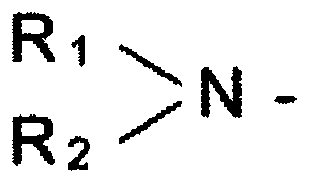Coated pigment, aqueous pigment dispersion, use thereof, and production method therefor
A technology of dispersion and pigment, applied in the field of pigment
- Summary
- Abstract
- Description
- Claims
- Application Information
AI Technical Summary
Problems solved by technology
Method used
Image
Examples
Embodiment
[0232] Hereinafter, although an Example is given and this invention is demonstrated concretely, this invention is not limited to an Example in particular. In addition, in an Example, "part" is "mass part", and "%" is "mass %".
[0233] (melting point)
[0234] Thermoplus TG8120 (manufactured by Rigaku Corporation) was used for the measurement of the melting point. For a sample of about 5 mg, the temperature was raised at an initial temperature of 25°C at a rate of 10°C / min, and the temperature was increased to 500°C. The obtained endothermic peak was read to obtain the melting point.
[0235] (acid value)
[0236] About 1 g of the sample was accurately weighed in the Erlenmeyer flask, and 50 ml of distilled water / dioxane (weight ratio: distilled water / dioxane=1 / 9) mixed liquid was added and dissolved. For the sample solution, using a potential difference measuring device (manufactured by Kyoto Electronics Industry Co., Ltd., device name "potential difference automatic titr...
Embodiment A1-1
[0369] The coating pigment (PA1-1), ion-exchanged water, and the basis for neutralization are weighed so that the pigment contained in the coating pigment in 100 parts of the pigment aqueous dispersion (DPA1-1) becomes 15 parts. The equivalent amount of dimethylaminoethanol calculated from the acid value and mass parts of the resin contained in the coating pigment is stirred with a high-speed mixer for 1 hour at a liquid temperature of 70 ° C, and the volatilized dimethylaminoethanol is adjusted by ion-exchanged water water, to obtain 100 parts of an aqueous pigment dispersion (DPA1-1). The particle size distribution of the obtained pigment aqueous dispersion was evaluated as the particle size distribution of the coating pigment (PA1-1). The particle size distribution was measured by dilution with ion-exchanged water using Nanotrac Wave (manufactured by Microtrac·BEL). The particle size distribution of the pigment dispersion (DPA1-1) was d1 = 25 nm, d50 = 53 nm, and d99 = 160...
Embodiment A1-2~ Embodiment A1-44、 comparative example A1-1~ comparative example A1-4
[0386] [Example A1-2 to Example A1-44, Comparative Example A1-1 to Comparative Example A1-4, Comparative Example A1-6]
[0387] Except changing coating pigment and alkaline substance into the composition shown in Table 7, obtain pigment aqueous dispersion (DPA1-2)~(DPA1-48) and ( DPA1-50). About the obtained pigment dispersion, the particle size distribution was measured similarly to Example (A1-1). The results of the particle size distribution are reported in Table 7.
PUM
| Property | Measurement | Unit |
|---|---|---|
| acid value | aaaaa | aaaaa |
| melting point | aaaaa | aaaaa |
| particle size | aaaaa | aaaaa |
Abstract
Description
Claims
Application Information
 Login to View More
Login to View More - R&D
- Intellectual Property
- Life Sciences
- Materials
- Tech Scout
- Unparalleled Data Quality
- Higher Quality Content
- 60% Fewer Hallucinations
Browse by: Latest US Patents, China's latest patents, Technical Efficacy Thesaurus, Application Domain, Technology Topic, Popular Technical Reports.
© 2025 PatSnap. All rights reserved.Legal|Privacy policy|Modern Slavery Act Transparency Statement|Sitemap|About US| Contact US: help@patsnap.com



